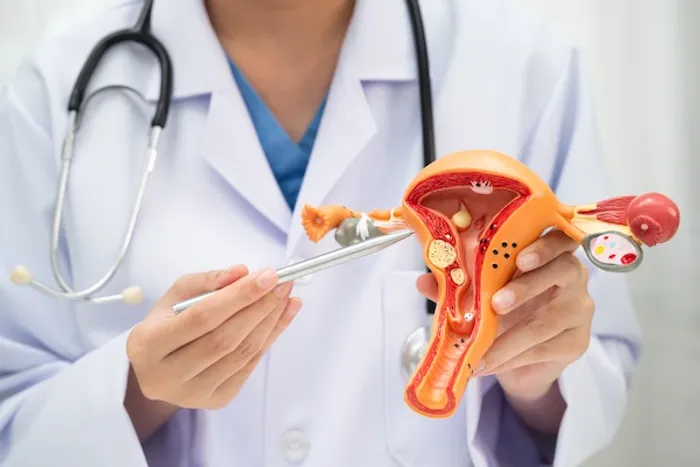Guide to Gynaecological Oncology
Know about the gynaecological cancer, what it is, screening, symptoms, risks, diagnosis and treatment options. Learn about how to live well with gynaecological cancer, types and more.

Written by Dr. Rohinipriyanka Pondugula
Reviewed by Dr. Md Yusuf Shareef MBBS
Last updated on 23rd Oct, 2025

Introduction
Gynecologic cancers affect the uterus, cervix, ovaries, fallopian tubes, vulva, and vagina, organs central to women’s health at every age. This guide to category/gynecologic oncology is designed for the general public seeking clear, trustworthy health advice. You’ll learn what category/gynecologic oncology includes, early signs to watch, how screening works, what diagnosis and staging mean, evidence-based treatments, and practical tips for living well during and after care. We’ve reviewed leading medical sources and top-ranking webpages on gynecologic oncology to distil what truly matters, then added insights you won’t find elsewhere, like how to read your pathology report, which questions to ask a specialist, and how to navigate costs or clinical trials. If symptoms persist beyond two weeks or you’re worried about your risk, consult a doctor online with Apollo 24|7 for further evaluation.
Understanding Gynaecologic Oncology: Conditions It Covers
Gynaecologic oncology focuses on cancers of the female reproductive system. These cancers share some risk factors and evaluation steps, but their biology and treatments can vary significantly.
The major cancer types
- Cervical cancer: Often linked to persistent high-risk HPV infection; preventable with vaccination and screening.
- Endometrial (uterine) cancer: Common after menopause; early sign is postmenopausal bleeding.
- Ovarian and fallopian tube cancer: Often diagnosed later due to subtle symptoms; genetic factors (BRCA, Lynch) are key.
- Vulvar and vaginal cancers: Less common; sometimes linked to HPV.
- Gestational trophoblastic disease: Rare tumours related to pregnancy tissue.
Consult Top Gynaecology Doctors for Personalised Advice
Why subspecialty care matters
Gynecologic oncologists are surgeons with specialised training in chemotherapy, targeted therapies, and multidisciplinary cancer care. Seeing one early can improve survival, especially for ovarian cancer, where optimal surgical staging and debulking are critical.
How do gynaecologic oncology clinics work?
- Team-based: surgeon, medical oncologist, radiation oncologist, genetics counsellor, fertility specialist, and palliative care.
- Personalised: pathology, genomics (e.g., BRCA, mismatch repair), and stage inform treatment choices.
Symptoms and When to Seek Care
Recognising early warning signs can lead to earlier diagnosis and better outcomes in the category/gynecologic oncology.
Common symptoms by site
- Cervical: postcoital bleeding, intermenstrual bleeding, unusual discharge, pelvic pain.
- Endometrial: postmenopausal bleeding, bleeding between periods.
- Ovarian/fallopian tube: persistent bloating, pelvic/abdominal pain, early satiety, urinary urgency/frequency; symptoms that persist >2 weeks matter more than intensity.
- Vulvar: itching, pain, non-healing ulcer, colour change.
- Vaginal: bleeding after sex, discharge, mass.
When to seek medical care
- Any postmenopausal bleeding warrants evaluation.
- New, persistent pelvic or abdominal symptoms (bloating, pain, fullness) lasting beyond two weeks deserve attention.
- Abnormal bleeding or discharge that doesn’t resolve should be assessed.
If symptoms persist beyond two weeks, consult a doctor online with Apollo 24|7 for further evaluation. If your condition does not improve after trying these measures, book a physical visit to a doctor with Apollo 24|7.
Myths versus facts
- Myth: Pap tests screen for ovarian cancer. Fact: There is no routine screening test for ovarian cancer.
- Myth: A normal pelvic exam rules out cancer. Fact: Some cancers aren’t easily detected by exam alone and need imaging or biopsy.
- Myth: Only older women get gynecologic cancers. Fact: HPV-related cervical cancer and some ovarian cancers can affect younger adults.
Risk Factors and Prevention
Prevention is a cornerstone of category/gynecologic oncology, with tools ranging from vaccines to genetic counselling.
HPV vaccination
Protects against the strains that cause most cervical, many vaginal and vulvar cancers. The CDC recommends HPV vaccination starting at ages 11–12, with catch-up vaccination up to age 26; some adults 27–45 may benefit after discussion with a clinician [2].
Population studies show dramatic reductions in cervical precancer and cancer after vaccine introduction.
Genetics and family history
- BRCA1/2 mutations raise ovarian and fallopian tube cancer risk; Lynch syndrome increases endometrial and other cancer risks.
- Ask your clinician about genetic testing if you have:
- Multiple relatives with breast, ovarian, endometrial, or colorectal cancer
- Early-onset cancers in the family
- Known family mutation
- Risk-reducing options include enhanced surveillance, oral contraceptives (for ovarian risk reduction), or risk-reducing surgery after childbearing.
Hormones and metabolic health
Unopposed estrogen, obesity, and insulin resistance increase endometrial cancer risk [3].
Lifestyle approaches—healthy weight, physical activity, balanced diet—reduce risk across several gynecologic cancers.
Other modifiable risks
- Don’t smoke; smoking increases cervical and vulvar cancer risk.
- Practice safer sex and limit the number of sexual partners to reduce HPV exposure.
Screening and Early Detection
Screening can prevent cancer (by finding and treating precancer) or detect it earlier. In category of gynecologic oncology, screening differs by site
Cervical cancer screening (Pap and HPV testing)
- Ages 21–29: Pap test every 3 years.
- Ages 30–65: Preferred options include primary high-risk HPV testing every 5 years, co-testing (HPV + Pap) every 5 years, or Pap alone every 3 years (follow local and clinician guidance).
- Stop after 65 if you had adequate negative prior screening and no history of significant precancer; continue longer if risk factors exist.
Endometrial cancer
- No routine screening for average-risk people.
- Report any postmenopausal bleeding immediately.
- Those with Lynch syndrome should discuss earlier and periodic evaluation.
Ovarian cancer
- No effective screening test for average-risk individuals; CA-125 and transvaginal ultrasound are not recommended screening tests [3]. High-risk people may consider surveillance in the context of a personalized plan.
H3: Vulvar and vaginal cancers
- No population screening; stay aware of symptoms and maintain routine gynecologic care.
Note: If your clinician orders labs (e.g., CBC, HbA1c) to optimize your health before procedures, Apollo 24|7 offers convenient home collection for tests like vitamin D or HbA1c.
Related long-tail keywords: cervical cancer screening guidelines 2024; endometrial cancer postmenopausal bleeding.
Diagnosis and Staging: What to Expect
When a symptom or screening test raises concern, the next steps in category/gynecologic oncology aim to confirm the diagnosis, define the stage, and personalize care [1][5].
The diagnostic work-up
- Pelvic exam and colposcopy (for abnormal cervical tests).
- Imaging: ultrasound (especially transvaginal), MRI or CT for staging, and sometimes PET/CT to assess spread.
- Biopsy: tissue sampling is definitive—examples include endometrial biopsy for abnormal uterine bleeding, or core needle biopsy for suspicious masses.
- Pathology: histology (e.g., high-grade serous, endometrioid), grade, and molecular markers (e.g., p53, mismatch repair, BRCA) guide therapy.
Staging systems
- FIGO staging (widely used in gynecologic oncology) and TNM staging describe tumor size, nodes, and metastasis, which influence prognosis and treatment.
- Surgical staging (especially for ovarian cancer) may include removing the uterus, ovaries, fallopian tubes, lymph nodes, and omentum, plus peritoneal biopsies to check microscopic spread.
Treatment Options and Personalised Care
Treatment in the category/gynecologic oncology is tailored to the cancer type, stage, tumour biology, overall health, and personal priorities such as fertility.
Surgery
- Cervical cancer: options range from cone biopsy to radical hysterectomy; fertility-sparing trachelectomy may be possible in early-stage disease.
- Endometrial cancer: hysterectomy with bilateral salpingo-oophorectomy, sentinel lymph node mapping; minimally invasive surgery reduces recovery time.
- Ovarian/fallopian tube cancer: comprehensive staging and cytoreductive (debulking) surgery; survival improves when performed by gynecologic oncologists..
Radiation therapy
External beam radiation and brachytherapy are common in cervical and endometrial cancers, sometimes combined with chemotherapy to enhance effectiveness.
Systemic therapy
- Chemotherapy: platinum-based regimens form the backbone for many gynecologic cancers.
- Targeted therapy: PARP inhibitors (e.g., for BRCA-mutated ovarian cancer) have improved progression-free survival in maintenance settings; anti-angiogenic agents (like bevacizumab) are used in selected cases.
- Immunotherapy: Checkpoint inhibitors (e.g., pembrolizumab) can be effective for mismatch repair-deficient endometrial cancer and in some cervical cancer settings [1][5].
Fertility-sparing options
- Carefully selected early-stage cervical cancer can be treated with conization or radical trachelectomy.
- Hormone therapy (e.g., progestins) with close monitoring may be used in select early endometrial cancer patients desiring to preserve fertility.
Multidisciplinary and supportive care
- Pain management, nutrition, pelvic floor therapy, and psychosocial support are integral.
- Teleconsultations can help you compare treatment plans; if you need fast guidance on next steps, consult a doctor online with Apollo 24|7.
Living Well During and After Treatment
Survivorship is an essential part of category/gynecologic oncology—focused on side-effect management, quality of life, and long-term health.
Managing side effects
- - Short-term: nausea, fatigue, hair loss, infections, surgical pain—ask about anti-nausea medications, growth factor support, and enhanced recovery protocols.
- - Long-term: neuropathy, premature menopause, sexual dysfunction, lymphedema; pelvic rehab and sexual health counseling can help.
- - Keep a symptom diary; share changes promptly.
H3: Fertility, menopause, and sexual health
- - Ask early about egg/embryo freezing or ovarian tissue preservation if fertility is a priority.
- - Nonhormonal and, when appropriate, carefully selected hormonal therapies can help with menopausal symptoms—discuss risks and benefits with your team.
- Lubricants, vaginal moisturisers, and pelvic floor therapy can improve sexual function after treatment.
Mental health, family, and work
Anxiety and depression are common; counselling, peer groups, and mindfulness can help. Caregivers need support, too—schedule breaks and share responsibilities.
Survivorship care plan
A written plan should summarise diagnosis, treatments, potential late effects, and follow-up schedule. Bring it to all future appointments.
Costs, insurance, and clinical trials
- Ask your care team to connect you with financial counsellors, social workers, and patient assistance programs.
- Clinical trials can offer access to cutting-edge therapies; search options through NCI or discuss with your specialist
Vaccines and prevention
HPV vaccination continues to reduce cervical precancers and cancers at a population level [2].
Therapeutic vaccines and novel combinations are under study.
Early detection and liquid biopsy
Research is ongoing in blood-based biomarkers and circulating tumour DNA to detect recurrence earlier and guide treatment—promising but not yet standard.
How to Choose a Specialist and Prepare for Your Visit
Finding the right team is one of the most important decisions in the category/gynecologic oncology,
Choosing a gynecologic oncologist
- Look for board certification, hospital volumes, clinical trial access, and a team-based program (surgery, medical oncology, radiation).
- Ask about experience with your exact cancer type and stage.
Questions to bring
- What stage is my cancer, and how was it determined?
- What are my treatment options and goals?
- Am I eligible for fertility-sparing therapy or clinical trials?
- What side effects should I expect, and how will you help manage them?
- What will follow-up look like?
Practical prep
- Bring your pathology report, imaging, and medication list.
- Write down symptoms and timelines.
- Consider a trusted support person for note-taking.
- If you need quick guidance before an in-person visit, consult a doctor online with Apollo 24|7.
How to Read Your Pathology and Imaging Reports
Medical reports can feel overwhelming. Here’s a plain-language decoder for category/gynecologic oncology.
Pathology
- Histology: cell type (e.g., endometrioid, serous).
- Grade: how aggressive cells look (1–3 high-grade).
- Margins: whether cancer cells are at the edge of the removed tissue.
- Lymphovascular invasion: cancer cells in small vessels; can raise recurrence risk.
- Biomarkers: ER/PR, p53, mismatch repair (dMMR), BRCA or homologous recombination deficiency can open targeted treatment options.
Imaging
Size and location of masses, lymph node status, and possible spread to nearby or distant organs.
Words like “suspicious,” “indeterminate,” or “metastatic” guide next steps (biopsy or closer follow-up).
If something isn’t clear, ask your clinician to explain it line by line; it’s your right to understand every term.
Conclusion
Category/gynecologic oncology brings together prevention, early detection, precise diagnosis, and multidisciplinary treatments to help people live longer, healthier lives. The biggest wins happen when you act early: get HPV vaccinated if eligible, follow cervical screening schedules, and seek care promptly for persistent symptoms like unusual bleeding or pelvic discomfort. If gynecologic cancer is diagnosed, ask to see a gynecologic oncologist—these specialists coordinate surgery, systemic therapies, and radiation while keeping your priorities, like fertility and quality of life, front and centre. If you’re worried about symptoms or need fast guidance, consult a doctor online with Apollo 24|7. Taking informed, timely steps is the most powerful thing you can do for your health in the category/gynecologic oncology.
Consult Top Gynaecology Doctors for Personalised Advice
Consult Top Gynaecology Doctors for Personalised Advice

Dr. Sreeparna Roy
Obstetrician and Gynaecologist
8 Years • MBBS , MS (OBSTETRICS & GYNAECOLOGY), Fellowship in Infertility, Endoscopy & Ultrasonography), Fellowship in Laparoscopy & Hysteroscopy,DRM
Kolkata
Dr Utsa Basu Clinic, Kolkata

Dr. Sai Lakshmi Daayana
Gynaecological Oncologist
18 Years • MBBS, MRCOG
Hyderabad
Apollo Hospitals Jubilee Hills, Hyderabad
(200+ Patients)

Dr. Rupam Manna
Radiation Specialist Oncologist
4 Years • MBBS MD(RADIO THERAPY)
Barasat
Diab-Eat-Ease, Barasat
Dr. Navin Srinivasan
Gynaecological Oncologist
9 Years • MBBS, MS DNB(OBS-GYNAE), MCH (GYNAE ONCOLOGY)
Bengaluru
Apollo Clinic Mahadevapura, Bengaluru

Dr. Revathi S Rajan
Obstetrician and Gynaecologist
24 Years • MBBS, DGO, DNB.FFMM
Bengaluru
Apollo Clinic, JP nagar, Bengaluru
Consult Top Gynaecology Doctors for Personalised Advice

Dr. Sreeparna Roy
Obstetrician and Gynaecologist
8 Years • MBBS , MS (OBSTETRICS & GYNAECOLOGY), Fellowship in Infertility, Endoscopy & Ultrasonography), Fellowship in Laparoscopy & Hysteroscopy,DRM
Kolkata
Dr Utsa Basu Clinic, Kolkata

Dr. Sai Lakshmi Daayana
Gynaecological Oncologist
18 Years • MBBS, MRCOG
Hyderabad
Apollo Hospitals Jubilee Hills, Hyderabad
(200+ Patients)

Dr. Rupam Manna
Radiation Specialist Oncologist
4 Years • MBBS MD(RADIO THERAPY)
Barasat
Diab-Eat-Ease, Barasat
Dr. Navin Srinivasan
Gynaecological Oncologist
9 Years • MBBS, MS DNB(OBS-GYNAE), MCH (GYNAE ONCOLOGY)
Bengaluru
Apollo Clinic Mahadevapura, Bengaluru

Dr. Revathi S Rajan
Obstetrician and Gynaecologist
24 Years • MBBS, DGO, DNB.FFMM
Bengaluru
Apollo Clinic, JP nagar, Bengaluru
More articles from General Medical Consultation
Frequently Asked Questions
What are the early warning signs of gynecologic cancer?
Persistent bloating, pelvic or abdominal pain, abnormal bleeding (including postmenopausal bleeding), unusual discharge, or vulvar changes are common early signs. If symptoms last beyond two weeks, consult a doctor online with Apollo 24|7 for further evaluation. Related term: symptoms of gynecologic cancer.
How often should I get a Pap or HPV test?
Most adults 21–29 need a Pap every 3 years; ages 30–65 can consider primary HPV testing every 5 years, co-testing every 5 years, or Pap alone every 3 years. Follow your clinician’s guidance and local policies. Related term: cervical cancer screening guidelines 2024.
Can I reduce my ovarian cancer risk?
Discuss family history and, if appropriate, genetic testing for BRCA or Lynch syndrome. Oral contraceptives, parity, and risk-reducing surgery for high-risk individuals can help. There’s no routine screening for average-risk people. Related terms: BRCA and ovarian cancer risk; clinical trials gynecologic oncology.
Is fertility-sparing treatment possible?
Yes, in select early-stage cases (e.g., conization or trachelectomy for cervical cancer; hormonal therapy for some early endometrial cancers) under close supervision. Ask a gynecologic oncologist about your options. Related term: fertility-sparing surgery cervical cancer.
What is a survivorship care plan?
It summarizes your diagnosis, treatments, potential late effects, and follow-up schedule, helping you and future clinicians manage long-term health. Related term: survivorship plan after gynecologic cancer.




